
In view of the changes made to the European Union vehicle type-approval legislation, Luxembourg will implement the transition from the New European Driving Cycle (NEDC) to the new Worldwide Harmonised Light Vehicle Test Procedure (WLTP) on 1 January 2021.
By the law of 15 December 2020 amending the legislation in force relating to the tax on road vehicles, the values of CO2 emissions per kilometre determined according to the new WLTP approval test cycle will be used from 2021 for the calculation of the tax on new passenger cars (category M1). The formula for calculating the tax in question remains unchanged.
The values of the new WLTP test cycle are not applied retroactively, meaning that the NEDC value will continue to be applied for all passenger cars for which a first entry into service in Europe was made before 1 January 2021, until the final decommissioning of the vehicle. The WLTP value will be applied for the calculation of the road vehicle tax for all new passenger cars that will be registered for the first time from 1 January.
For internal combustion engines, CO2 emissions per kilometre in WLTP are on average around 20% higher than the equivalent value in NEDC. However, the values of the WLTP test cycle correspond more to the actual emissions and consumption values of the vehicles. Thus, the transition to the new test cycle is expected to be able to better inform consumers who will then have the possibility of choosing a new low-emission vehicle and being granted a more advantageous tax on the road vehicle as well as knowing the fuel costs they will face. With the average age of the car fleet in Luxembourg currently standing at 6.5 years and manufacturers having to make efforts to reduce the CO2 emissions of their vehicles placed on the market, it is likely that the CO2 value for a new vehicle determined according to the new WLTP test cycle will not be higher than for an old vehicle aged 6.5 years whose emissions have been assessed in accordance with the NEDC test cycle.
It is recommended that the future owners of passenger cars obtain information before any purchase of a new vehicle from their car dealers, who will provide further information on the level of CO2 emissions of their vehicles depending on the model chosen and desired options.








